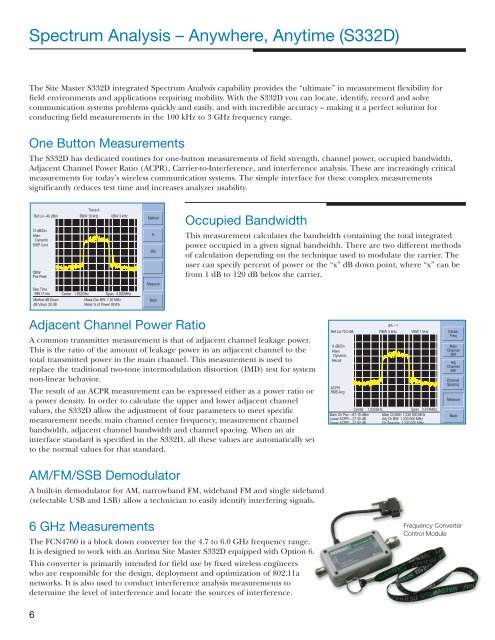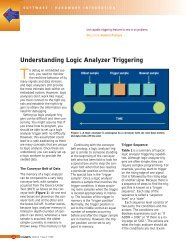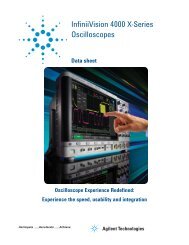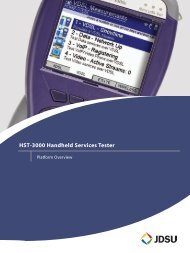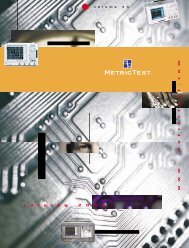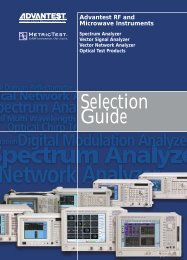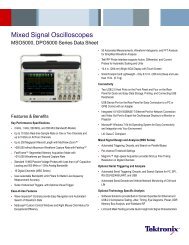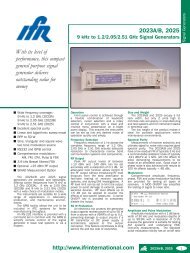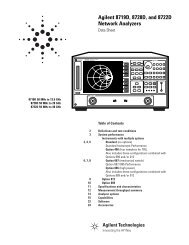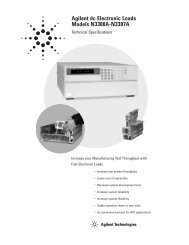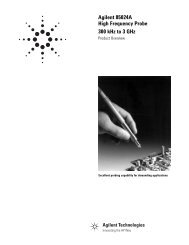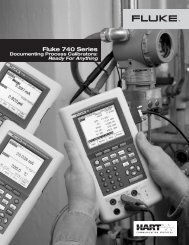Site Master S331D_S332D
Site Master S331D_S332D
Site Master S331D_S332D
You also want an ePaper? Increase the reach of your titles
YUMPU automatically turns print PDFs into web optimized ePapers that Google loves.
Spectrum Analysis – Anywhere, Anytime (<strong>S332D</strong>)<br />
The <strong>Site</strong> <strong>Master</strong> <strong>S332D</strong> integrated Spectrum Analysis capability provides the “ultimate” in measurement flexibility for<br />
field environments and applications requiring mobility. With the <strong>S332D</strong> you can locate, identify, record and solve<br />
communication systems problems quickly and easily, and with incredible accuracy – making it a perfect solution for<br />
conducting field measurements in the 100 kHz to 3 GHz frequency range.<br />
One Button Measurements<br />
The <strong>S332D</strong> has dedicated routines for one-button measurements of field strength, channel power, occupied bandwidth,<br />
Adjacent Channel Power Ratio (ACPR), Carrier-to-Interference, and interference analysis. These are increasingly critical<br />
measurements for today’s wireless communication systems. The simple interface for these complex measurements<br />
significantly reduces test time and increases analyzer usability.<br />
Occupied Bandwidth<br />
This measurement calculates the bandwidth containing the total integrated<br />
power occupied in a given signal bandwidth. There are two different methods<br />
of calculation depending on the technique used to modulate the carrier. The<br />
user can specify percent of power or the “x” dB down point, where “x” can be<br />
from 1 dB to 120 dB below the carrier.<br />
Adjacent Channel Power Ratio<br />
A common transmitter measurement is that of adjacent channel leakage power.<br />
This is the ratio of the amount of leakage power in an adjacent channel to the<br />
total transmitted power in the main channel. This measurement is used to<br />
replace the traditional two-tone intermodulation distortion (IMD) test for system<br />
non-linear behavior.<br />
The result of an ACPR measurement can be expressed either as a power ratio or<br />
a power density. In order to calculate the upper and lower adjacent channel<br />
values, the <strong>S332D</strong> allow the adjustment of four parameters to meet specific<br />
measurement needs: main channel center frequency, measurement channel<br />
bandwidth, adjacent channel bandwidth and channel spacing. When an air<br />
interface standard is specified in the <strong>S332D</strong>, all these values are automatically set<br />
to the normal values for that standard.<br />
AM/FM/SSB Demodulator<br />
A built-in demodulator for AM, narrowband FM, wideband FM and single sideband<br />
(selectable USB and LSB) allow a technician to easily identify interfering signals.<br />
6 GHz Measurements<br />
The FCN4760 is a block down converter for the 4.7 to 6.0 GHz frequency range.<br />
It is designed to work with an Anritsu <strong>Site</strong> <strong>Master</strong> <strong>S332D</strong> equipped with Option 6.<br />
This converter is primarily intended for field use by fixed wireless engineers<br />
who are responsible for the design, deployment and optimization of 802.11a<br />
networks. It is also used to conduct interference analysis measurements to<br />
determine the level of interference and locate the sources of interference.<br />
Frequency Converter<br />
Control Module<br />
6


